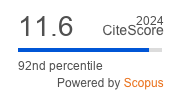PULMONARY EMPHYSEMA ANALYSIS USING SHEARLET BASED TEXTURES AND RADIAL BASIS FUNCTION NETWORK
DOI:
https://doi.org/10.29284/ijasis.6.1.2020.1-11Keywords:
Pulmonary emphysema, shearlets, computed tomography, pulmonary diseases, neural networkAbstract
The emergence of High Resolution Computed Tomography (HRCT) images of the lungs clearly shows the parenchymal lung architecture and thus the quantification of obstructive lung disease becomes most accurate. In this study, an automated system to diagnose obstructive lung disease called emphysema is presented using HRCT images of the lungs. The kind of texture information that ideally can be extracted from HRCT images depends on the multi-resolution representation system. The proposed Pulmonary Emphysema Analysis (PEA) system employs Shearlets as it can extracts more texture information than wavelets in different directions and levels. Radial Basis Function Network (RBFN) is employed for the classification of HRCT images into three categories; Normal Tissue (NT), Paraseptal Emphysema (PSE) and Centrilobular Emphysema (CLE). Results prove that a confident diagnosis of pulmonary emphysema is established to help clinicians which will also increase the precision of diagnosis.
References
M.J. Gangeh, L. Sørensen, S.B. Shaker, M.S. Kamel, M. de Bruijne, and M. Loog, “A texton-based approach for the classification of lung parenchyma in CT images”, International conference on Medical Image Computing and Computer Assisted Intervention, 2010, pp. 595-602.
M.J. Gangeh, L. Sørensen, S.B. Shaker, M.S. Kamel and M. de Bruijne, “Multiple classifier systems in texton-based approach for the classification of CT images of lung”, International workshop on Medical Computer Vision . Recognition Techniques and Applications in Medical Imaging, 2010, pp. 153-163.
C. Dharmagunawardhana, S. Mahmood, M. Bennett, and M. Niranjan, “Quantitative analysis of pulmonary emphysema using isotropic Gaussian Markov random fields”, International Conference on Computer Vision Theory and Applications, 2014, pp. 44-53
R. Nava, B. Escalante-Ramírez, G. Cristóbal, and R.S.J. Estépar, “Extended Gabor approach applied to classification of emphysematous patterns in computed tomography”, Medical & Biological Engineering & Computing, Vol. 52, No. 4, 2014, pp. 393-403.
X. Pei, “Emphysema Classification Using Convolutional Neural Networks”, Intelligent Robotics and Applications, 2015, pp. 455-461.
R. Nava, J. Olveres, J. Kybic, B. Escalante, G. Cristóbal, “Feature Ensemble for Quantitative Analysis of Emphysema in CT imaging”, IEEE International Conference on E-Health and Bioengineering, 2015, pp. 1-4.
G.L.B. Ramalhoa, D.S. Ferreiraa, P.P.R. Filhoa, F.N.S. de Medeiros, “Rotation-invariant Feature Extraction using a Structural Co-occurrence Matrix”, Measurement, Vol. 94, 2016, pp. 406-415.
V. Srivastava and R.K. Purwar, “A Five-Level Wavelet Decomposition and Dimensional Reduction Approach for Feature Extraction and Classification of MR and CT Scan Images”, Applied Computational Intelligence and Soft Computing, Vol. 2017, 2017, pp. 1-9.
M.A. Ibrahim, O.A. Ojo, P.A. Oluwafisoye, “Identification of emphysema patterns in high resolution computed tomography images”, Journal of Biomedical Engineering and Informatics, Vol. 4, No. 1, 2018, pp. 16-24.
S.J. Narayanan, R. Soundrapandiyan, B. Perumal, C.J. Baby, “Emphysema Medical Image Classification Using Fuzzy Decision Tree with Fuzzy Particle Swarm Optimization Clustering”, International Conference on Smart Intelligent Computing and Applications, 2018, pp. 305-313.
P.K.R. Yelampalli, J. Nayak, V.H. Gaidhane, “A novel binary feature descriptor to discriminate normal and abnormal chest CT images using dissimilarity measures”, Pattern Analysis and Applications, Vol. 22, No. 4, 2019, pp. 1517-1526.
E. Tuba, I. Strumberger, N. Bacanin, M. Tuba, “Analysis of local binary pattern for emphysema classification in lung CT image”, IEEE International Conference on Electronics, Computers and Artificial Intelligence , 2019, pp. 1-5 .
Mallat S. A wavelet tour of signal processing: the sparse way. Academic Press; 2008
M.N. Do and M. Vetterli, “The contourlet transform: an efficient directional multiresolution image representation”, IEEE Transactions on image processing, Vol. 14, no. 12, 2005, pp. 2091-2106.
D. Donoho and E. Candes, “Continuous curvelet transform: II. Discretization and frames”, Applied and Computational Harmonic Analysis, Vol. 19, No. 2, 2005, pp. 198-222.
W.Q. Lim, “The discrete shearlet transform: a new directional transform and compactly supported shearlet frames”, IEEE Transactions on Image Processing, Vol. 19, No. 5, 2010, pp. 1166-1180.
G. Easley, D. Labate and W.Q. Lim, “Sparse directional image representations using the discrete shearlet transform”, Applied and Computational Harmonic Analysis, Vol. 25, No. 1, 2008, pp. 25-46.
R.R. Ayalapogu, S. Pabboju and R.R. Ramisetty, “Analysis of dual tree M‐band wavelet transform based features for brain image classification”, Magnetic resonance in medicine, Vol. 80, no. 6, 2018, pp. 2393-2401.
K.S. Thivya, P. Sakthivel and P.M. Venkata Sai, “Analysis of framelets for breast cancer diagnosis”, Technology and Health Care, Vol. 24, No. 1, 2016, pp. 21-29.
L. Sardo and J. Kittler, “Minimum complexity estimator for rbf networks architecture selection”, International Conference on Neural Networks, Vol. 1, 1996, pp. 137-142
Downloads
Published
Issue
Section
License
This work is licensed under a Creative Commons Attribution 4.0 International License, which permits unrestricted use, distribution, and reproduction in any medium, provided the original work is properly cited.











